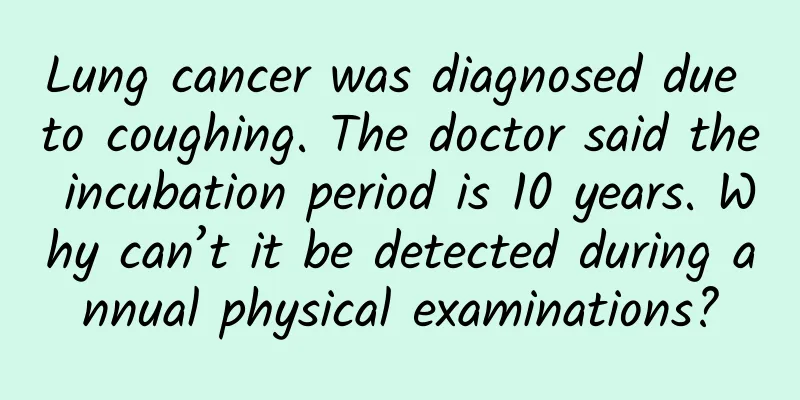Lung cancer was diagnosed due to coughing. The doctor said the incubation period is 10 years. Why can’t it be detected during annual physical examinations?

|
A patient complained to Huazi that he had an irritating cough with blood in his sputum, and was diagnosed with lung cancer at the hospital. He felt extremely wronged because the doctor told him that the incubation period of lung cancer is usually 10 to 20 years, but he had physical examinations every year. Why was the "devil" in his body hidden so deeply and not discovered until the disease occurred? 1. The incubation period of lung cancer is 10 years. Huazi told him that the doctor was right. In fact, not only is the incubation period of lung cancer usually more than 10 years, but most cancers have an extremely long incubation period. It's just that there are no obvious signs in the early stage and it will not be discovered. Cancer cells originate from the mutation of normal cells. The human body produces about 6,000 cancer cells every day, but when the immune system is normal, these cancer cells will be quickly cleared. In other words, cancer cells actually exist in everyone's body, but they will not develop when the body is healthy. However, when the body's immunity is weakened, or when carcinogenic factors cause the cell mutation to increase and exceed the immune system's ability to clear it, it will develop into cancer. 2. Early detection is the key to treating lung cancer As long as lung cancer is detected early, good treatment results can be achieved, but ordinary physical examinations cannot effectively screen for early lung cancer. Because ordinary physical examinations usually only include chest X-rays, this type of examination is not accurate enough and cannot detect early lung cancer. The current international authoritative organization recommends low-dose CT as a screening method for early lung cancer. This means using a low-dose CT with one-seventh the radiation dose of a normal CT to examine the lungs. It has good imaging effects, high inspection accuracy, and little radiation impact on the body, and can detect tiny early cancers. 3. People at high risk need to undergo lung cancer screening. Although the radioactivity of low-dose CT is very small, it still has a certain amount of radioactivity, so it is only recommended that people at high risk of lung cancer be screened once a year, not everyone needs to do it. People at high risk of lung cancer are those aged between 55 and 77 who have a long history of smoking. There is a calculation formula for determining long-term smoking, which is to multiply the number of packs smoked per day by the number of years of smoking, and the value is greater than or equal to 20. For example, if you smoke 1 pack of cigarettes a day and have smoked for 20 years, or 2 packs of cigarettes a day and have smoked for 10 years, the multiplied value is 20, and the risk is the same. If your age is within the range, even though you do not smoke, you are exposed to passive smoking, have occupational exposure to high carcinogens (such as asbestos, beryllium, uranium, radon, etc.), have suffered from other malignant tumors, or have other family members with lung cancer, or have a history of chronic obstructive pulmonary disease (COPD) or diffuse pulmonary fibrosis. You are also at high risk of lung cancer and need to be screened. 4. What is more important is to prevent lung cancer. Lung cancer has become the cancer with the highest incidence and mortality in China, but as long as you understand the causes of lung damage, you can prevent it correctly. 1. Smoking: The biggest cause of lung cancer is smoking. The smoke produced by burning cigarettes contains thousands of toxic substances, among which nicotine (nicotine), benzopyrene, amines, phenolic compounds, etc. are the main carcinogens. About 80% of lung cancer is related to smoking, so to prevent lung cancer, the first thing is to stay away from cigarettes. 2. High-risk occupations: Asbestos workers are 7 times more likely to develop lung cancer than the general population, because the asbestos inhaled at work is carcinogenic. In addition to asbestos workers, people who are exposed to toxic compounds such as arsenic, chromium, nickel, beryllium, cadmium, lead, formaldehyde, vinyl chloride, petroleum, soot, tar, etc. at work are also prone to lung cancer. Therefore, people with occupational exposure risks must take safety precautions at work. 3. Environmental pollution: Some non-smokers also suffer from lung cancer. According to the survey, most of them are related to environmental pollution. The pollution of kitchen fume and soot is an important cause of lung cancer in non-smoking women. Pay special attention to radon, which is a radioactive substance that is widely present in soil, rocks, and building materials and will enter the room with decoration. 5~15% of lung cancer patients are related to radon pollution. Therefore, in order to prevent lung cancer, the indoor environment should open more windows to ensure ventilation. Outdoor air pollution is also a factor that induces lung cancer. For example, factories that discharge pollutants near living areas, coal burning for heating in winter in northern regions, exhaust from cars on the road, asphalt roads, and waterproofing of houses can all cause air pollution. If you find a pollution source nearby, try to stay away from it. In summary, lung cancer is a cancer with a long incubation period, but it is difficult to detect early lung cancer through general physical examinations. High-risk groups should undergo a low-dose CT scan once a year to accurately screen for early lung cancer. Staying away from risk factors that induce lung cancer can effectively prevent the occurrence of lung cancer. I am pharmacist Huazi, welcome to follow me and share more health knowledge. |
<<: What are the benefits of dried mango? What are the nutritional values of dried mango?
>>: What is the difference between dried mango and mango crisp? When is mango ripe?
Recommend
What are the symptoms before menopause at the age of 50?
Menstruation is a normal physiological phenomenon...
Does feeding dried shrimps to tiger fish affect its growth? What is the best food for tiger fish?
Tiger fish are very common in our daily life. The...
Can I eat egg yolks during menstruation?
We all know that egg yolk is a food that contains...
What causes brown discharge after period?
Menstruation is a sign that women have entered pu...
What to do if the accessory breast of a pregnant woman is painful
Accessory breasts usually grow in front of or bel...
Foul-smelling vaginal discharge
If a woman's discharge has a strong odor, she...
Estrogen supplementation
Estrogen is a steroid hormone, which is mainly pr...
Medical treatment for ectopic pregnancy
Ectopic pregnancy is very harmful to women's ...
What does it feel like for a girl to be addicted to smoking?
In today's society, many women smoke, but aft...
Symptoms before menstruation
Some female friends will experience many symptoms...
What are the symptoms of milk compression?
Many unmarried and pregnant mothers do not know w...
Why does it cause swelling and pain down there when a woman has sex?
Sex is a very normal thing for adult men and wome...
What is the reason for small fleshy bumps on the vulva?
The female vulva is the most important part. If w...
Five situations in which women cannot take a bath
Paying attention to personal hygiene, such as tak...
Are you afraid of catching a cold due to gynecological inflammation?
Many women will have some gynecological inflammat...









